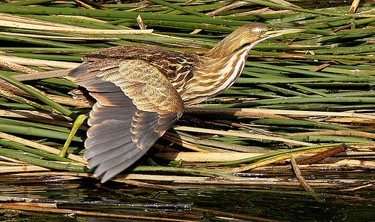The impact of wetland isolation and adjacent land use on bird communities
 American bittern (Botaurus lentiginosus) in flight on marsh. Credit, Linda Tanner.When assessing ecological function and quality of marshland ecosystems, new research from southern Ontario, Canada, indicates that adjacent land use and isolation of the marshlands are important factors to consider.
American bittern (Botaurus lentiginosus) in flight on marsh. Credit, Linda Tanner.When assessing ecological function and quality of marshland ecosystems, new research from southern Ontario, Canada, indicates that adjacent land use and isolation of the marshlands are important factors to consider.
McMaster University’s (Hamilton, Ontario) Lyndsay Smith and Patricia Chow-Fraser used the Index of Marsh Bird Community Integrity to examine the affects of adjacent land use and marsh isolation on wetland bird communities at 20 marshes along the north shores of Lakes Erie and Ontario. The study is published in the journal Environmental Management.
The research found obligate marsh-nesting birds (including american bittern and Virginia rail) preferred rural wetlands over urban with greater species richness and abundance at rural marshes compared to those in an urban setting.
Generalist marsh-nesting birds (including song sparrow and great blue heron) showed no difference in species richness or abundance, while synanthropic species (including mute swan) increased in both richness and abundance at urban marshes.
In terms of isolation from other marshes, the presence of other wetland habitats within 4km significantly influenced bird communities. Obligate marsh-nesting species in particular were more common in less isolated wetlands.
The authors are careful to note that notwithstanding this result, isolated marshes are still important. Some isolated marshes scored high values. In their highly urbanized study area centred on Canada’s largest city, Toronto, where over 80% of natural wetlands have been lost, retention of all wetland habitats is crucial.
The authors conclude that “urban development should not be the dominant land use within 1000 m of any wetland since it negatively affects the abundance and richness of obligate marsh-nesters, and the overall integrity of the avian community.”
--by Ian Adams
Smith, L., & Chow-Fraser, P. (2010). Impacts of Adjacent Land Use and Isolation on Marsh Bird Communities Environmental Management, 45 (5), 1040-1051 DOI: 10.1007/s00267-010-9475-5




 Birds
Birds
Reader Comments